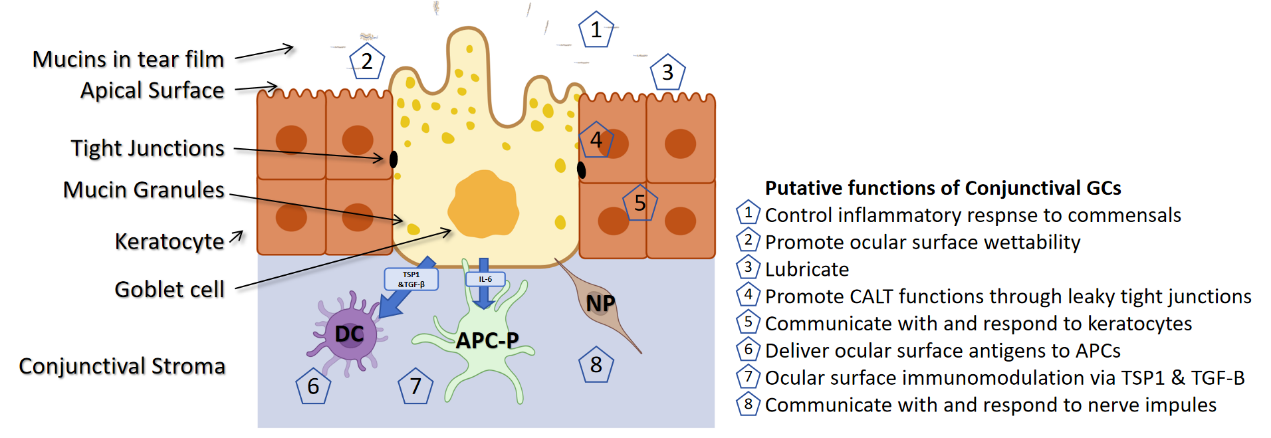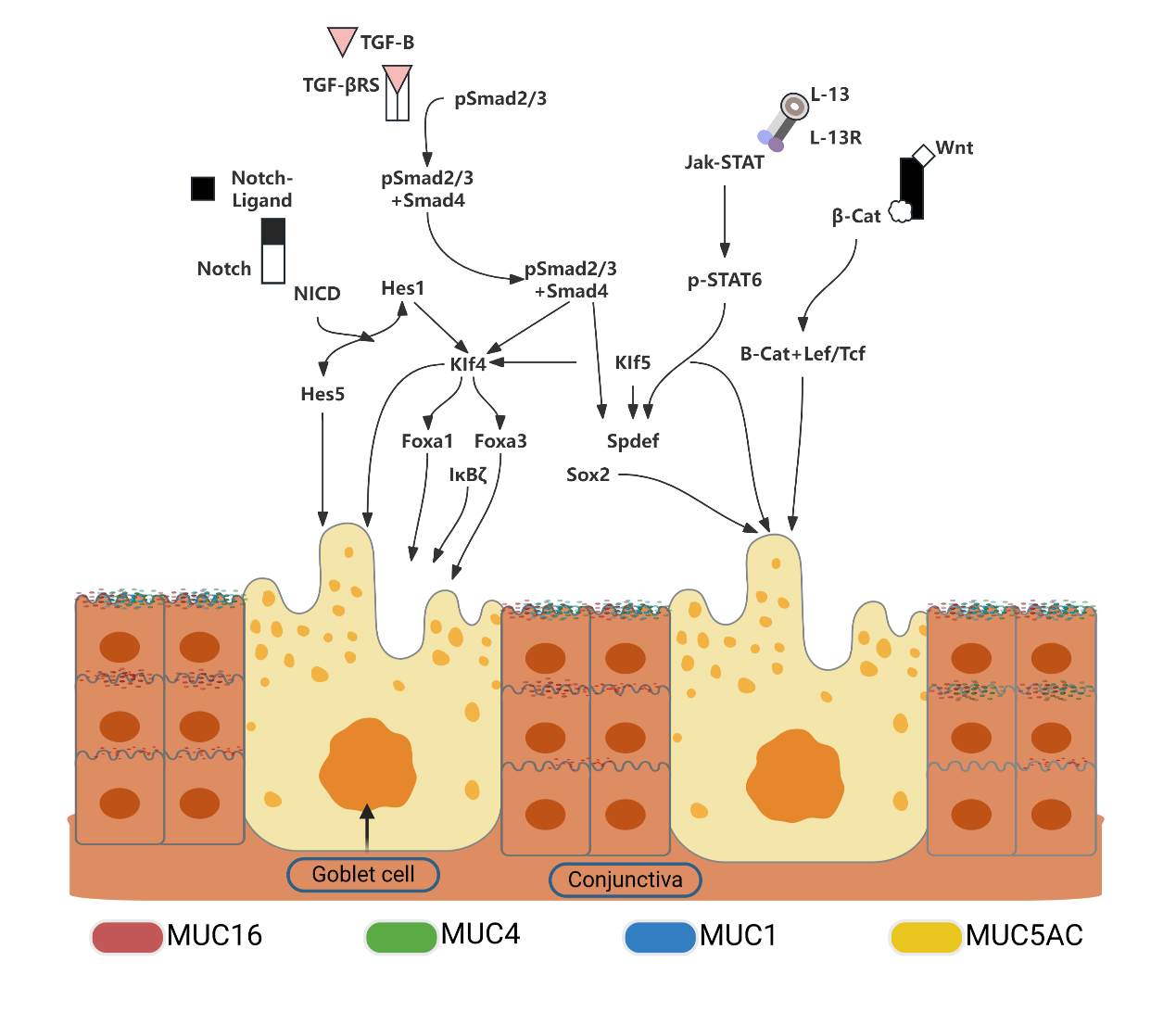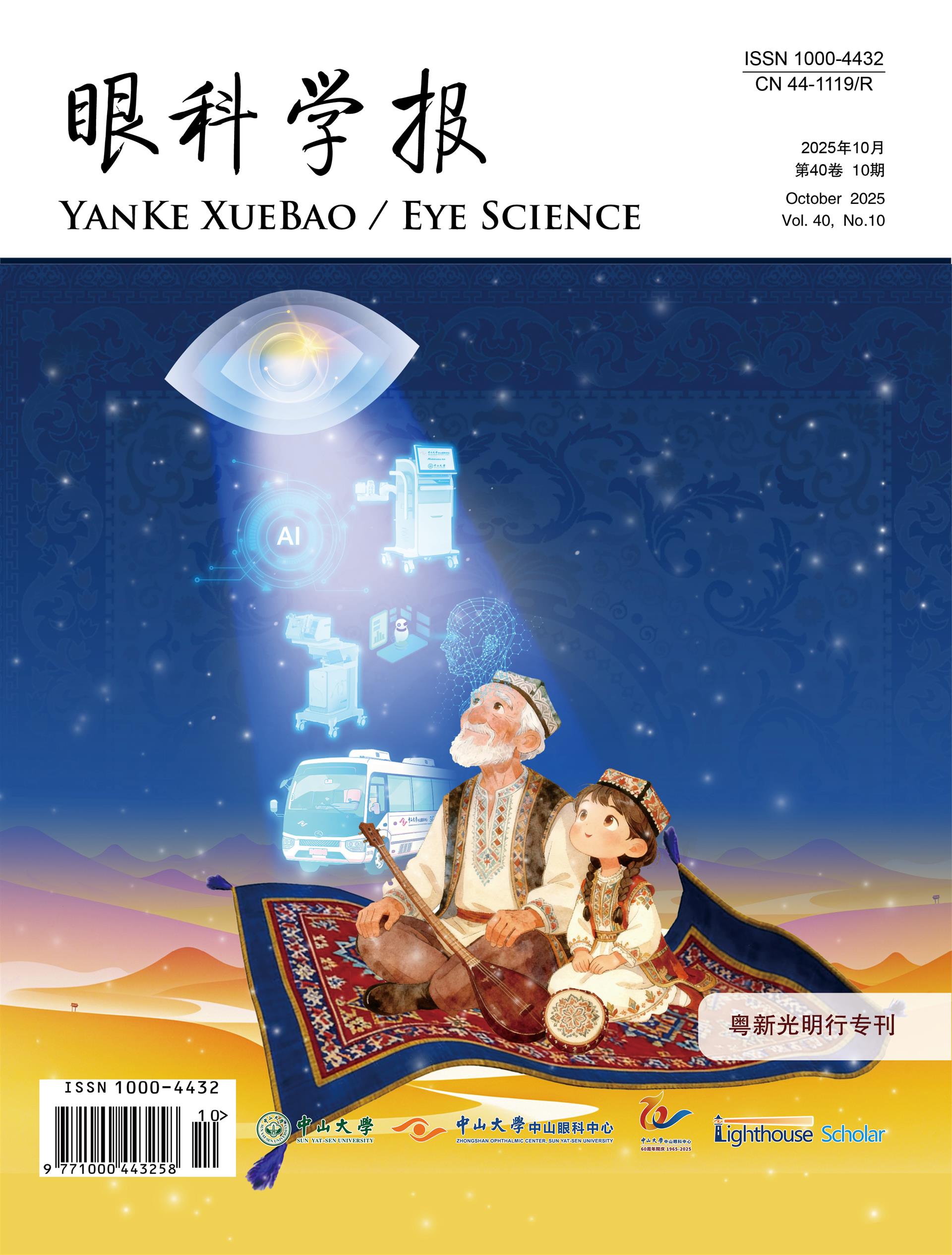1、Yao KT. Study on the relationship between tear film and
optical quality after corneal refraction operation using
Optical Quality Analysis System[D]. Anhui Medical
University. 2020.Yao KT. Study on the relationship between tear film and
optical quality after corneal refraction operation using
Optical Quality Analysis System[D]. Anhui Medical
University. 2020.
2、Dartt DA. Regulation of mucin and fluid secretion by
conjunctival epithelial cells. Prog Retin Eye Res. 2002,
21(6): 555-576. DOI: 10.1016/s1350-9462(02)00038-1.Dartt DA. Regulation of mucin and fluid secretion by
conjunctival epithelial cells. Prog Retin Eye Res. 2002,
21(6): 555-576. DOI: 10.1016/s1350-9462(02)00038-1.
3、Dartt DA, Hodges RR, Li D, et al. Conjunctival goblet
cell secretion stimulated by leukotrienes is reduced
by resolvins D1 and E1 to promote resolution of
inflammation. J Immunol. 2011, 186(7): 4455-4466. DOI:
10.4049/jimmunol.1000833.Dartt DA, Hodges RR, Li D, et al. Conjunctival goblet
cell secretion stimulated by leukotrienes is reduced
by resolvins D1 and E1 to promote resolution of
inflammation. J Immunol. 2011, 186(7): 4455-4466. DOI:
10.4049/jimmunol.1000833.
4、Knop E, Knop N. The role of eye-associated lymphoid
tissue in corneal immune protection. J Anat. 2005, 206(3):
271-285. DOI: 10.1111/j.1469-7580.2005.00394.x.Knop E, Knop N. The role of eye-associated lymphoid
tissue in corneal immune protection. J Anat. 2005, 206(3):
271-285. DOI: 10.1111/j.1469-7580.2005.00394.x.
5、Watanabe H, Fabricant M, Tisdale AS, et al. Human
corneal and conjunctival epithelia produce a mucin-like
glycoprotein for the apical surface. Invest Ophthalmol Vis
Sci. 1995, 36(2): 337-344.Watanabe H, Fabricant M, Tisdale AS, et al. Human
corneal and conjunctival epithelia produce a mucin-like
glycoprotein for the apical surface. Invest Ophthalmol Vis
Sci. 1995, 36(2): 337-344.
6、Marko CK, Menon BB, Chen G, et al. Spdef null mice
lack conjunctival goblet cells and provide a model of dry
eye. Am J Pathol. 2013, 183(1): 35-48. DOI: 10.1016/j.ajpath.2013.03.017.Marko CK, Menon BB, Chen G, et al. Spdef null mice
lack conjunctival goblet cells and provide a model of dry
eye. Am J Pathol. 2013, 183(1): 35-48. DOI: 10.1016/j.ajpath.2013.03.017.
7、Gipson IK, Spurr-Michaud S, Tisdale A, et al. Comparison
of the transmembrane mucins MUC1 and MUC16 in
epithelial barrier function. PLoS One. 2014, 9(6): e100393.
DOI: 10.1371/journal.pone.0100393.Gipson IK, Spurr-Michaud S, Tisdale A, et al. Comparison
of the transmembrane mucins MUC1 and MUC16 in
epithelial barrier function. PLoS One. 2014, 9(6): e100393.
DOI: 10.1371/journal.pone.0100393.
8、Gipson IK, Tisdale AS. Visualization of conjunctival
goblet cell actin cytoskeleton and mucin content in tissue
whole mounts. Exp Eye Res. 1997, 65(3): 407-415. DOI:
10.1006/exer.1997.0351.Gipson IK, Tisdale AS. Visualization of conjunctival
goblet cell actin cytoskeleton and mucin content in tissue
whole mounts. Exp Eye Res. 1997, 65(3): 407-415. DOI:
10.1006/exer.1997.0351.
9、Gipson IK, Spurr-Michaud S, Argüeso P, et al. Mucin gene
expression in immortalized human corneal-limbal and
conjunctival epithelial cell lines. Invest Ophthalmol Vis
Sci. 2003, 44(6): 2496-2506. DOI: 10.1167/iovs.02-0851.Gipson IK, Spurr-Michaud S, Argüeso P, et al. Mucin gene
expression in immortalized human corneal-limbal and
conjunctival epithelial cell lines. Invest Ophthalmol Vis
Sci. 2003, 44(6): 2496-2506. DOI: 10.1167/iovs.02-0851.
10、Yoshida Y, Ban Y, Kinoshita S. Tight junction
transmembrane protein claudin subtype expression and
distribution in human corneal and conjunctival epithelium.
Invest Ophthalmol Vis Sci. 2009, 50(5): 2103-2108. DOI:
10.1167/iovs.08-3046.Yoshida Y, Ban Y, Kinoshita S. Tight junction
transmembrane protein claudin subtype expression and
distribution in human corneal and conjunctival epithelium.
Invest Ophthalmol Vis Sci. 2009, 50(5): 2103-2108. DOI:
10.1167/iovs.08-3046.
11、Marko CK, Tisdale AS, Spurr-Michaud S, et al. The ocular
surface phenotype of Muc5ac and Muc5b null mice. Invest
Ophthalmol Vis Sci. 2014, 55(1): 291-300. DOI: 10.1167/
iovs.13-13194.Marko CK, Tisdale AS, Spurr-Michaud S, et al. The ocular
surface phenotype of Muc5ac and Muc5b null mice. Invest
Ophthalmol Vis Sci. 2014, 55(1): 291-300. DOI: 10.1167/
iovs.13-13194.
12、Wei ZG, Wu RL, Lavker RM, et al. In vitro growth and
differentiation of rabbit bulbar, fornix, and palpebral
conjunctival epithelia. Implications on conjunctival
epithelial transdifferentiation and stem cells. Invest
Ophthalmol Vis Sci. 1993, 34(5): 1814-1828.Wei ZG, Wu RL, Lavker RM, et al. In vitro growth and
differentiation of rabbit bulbar, fornix, and palpebral
conjunctival epithelia. Implications on conjunctival
epithelial transdifferentiation and stem cells. Invest
Ophthalmol Vis Sci. 1993, 34(5): 1814-1828.
13、Pellegrini G, Golisano O, Paterna P, et al. Location and
clonal analysis of stem cells and their differentiated
progeny in the human ocular surface. J Cell Biol. 1999,
145(4): 769-782. DOI: 10.1083/jcb.145.4.769.Pellegrini G, Golisano O, Paterna P, et al. Location and
clonal analysis of stem cells and their differentiated
progeny in the human ocular surface. J Cell Biol. 1999,
145(4): 769-782. DOI: 10.1083/jcb.145.4.769.
14、Wei ZG, Cotsarelis G, Sun TT, et al. Label-retaining
cells are preferentially located in fornical epithelium:
implications on conjunctival epithelial homeostasis. Invest
Ophthalmol Vis Sci. 1995, 36(1): 236-246.Wei ZG, Cotsarelis G, Sun TT, et al. Label-retaining
cells are preferentially located in fornical epithelium:
implications on conjunctival epithelial homeostasis. Invest
Ophthalmol Vis Sci. 1995, 36(1): 236-246.
15、Blalock TD, Spurr-Michaud SJ, Tisdale AS, et al.
Functions of MUC16 in corneal epithelial cells. Invest
Ophthalmol Vis Sci. 2007, 48(10): 4509-4518. DOI:
10.1167/iovs.07-0430.Blalock TD, Spurr-Michaud SJ, Tisdale AS, et al.
Functions of MUC16 in corneal epithelial cells. Invest
Ophthalmol Vis Sci. 2007, 48(10): 4509-4518. DOI:
10.1167/iovs.07-0430.
16、Jumblatt MM, McKenzie RW, Steele PS, et al. MUC7
expression in the human lacrimal gland and conjunctiva.
Cornea. 2003, 22(1): 41-45. DOI: 10.1097/00003226-
200301000-00010.Jumblatt MM, McKenzie RW, Steele PS, et al. MUC7
expression in the human lacrimal gland and conjunctiva.
Cornea. 2003, 22(1): 41-45. DOI: 10.1097/00003226-
200301000-00010.
17、Hori Y, Spurr-Michaud S, Russo CL, et al. Differential regulation of membrane-associated mucins in the human
ocular surface epithelium. Invest Ophthalmol Vis Sci.
2004, 45(1): 114-122. DOI: 10.1167/iovs.03-0903.Hori Y, Spurr-Michaud S, Russo CL, et al. Differential regulation of membrane-associated mucins in the human
ocular surface epithelium. Invest Ophthalmol Vis Sci.
2004, 45(1): 114-122. DOI: 10.1167/iovs.03-0903.
18、Arg%C3%BCeso%20P%2C%20Balaram%20M%2C%20Spurr-Michaud%20S%2C%20et%20al.%20Decreased%20%0Alevels%20of%20the%20goblet%20cell%20mucin%20MUC5AC%20in%20tears%20of%20%0Apatients%20with%20Sj%C3%B6gren%20syndrome.%20Invest%20Ophthalmol%20Vis%20%0ASci.%202002%2C%2043(4)%3A%201004-1011.Arg%C3%BCeso%20P%2C%20Balaram%20M%2C%20Spurr-Michaud%20S%2C%20et%20al.%20Decreased%20%0Alevels%20of%20the%20goblet%20cell%20mucin%20MUC5AC%20in%20tears%20of%20%0Apatients%20with%20Sj%C3%B6gren%20syndrome.%20Invest%20Ophthalmol%20Vis%20%0ASci.%202002%2C%2043(4)%3A%201004-1011.
19、McNamara%20NA%2C%20Gallup%20M%2C%20Porco%20TC.%20Establishing%20PAX6%20%0Aas%20a%20biomarker%20to%20detect%20early%20loss%20of%20ocular%20phenotype%20%0Ain%20human%20patients%20with%20Sj%C3%B6gren%E2%80%99s%20syndrome.%20Invest%20%0AOphthalmol%20Vis%20Sci.%202014%2C%2055(11)%3A%207079-7084.%20DOI%3A%20%0A10.1167%2Fiovs.14-14828.McNamara%20NA%2C%20Gallup%20M%2C%20Porco%20TC.%20Establishing%20PAX6%20%0Aas%20a%20biomarker%20to%20detect%20early%20loss%20of%20ocular%20phenotype%20%0Ain%20human%20patients%20with%20Sj%C3%B6gren%E2%80%99s%20syndrome.%20Invest%20%0AOphthalmol%20Vis%20Sci.%202014%2C%2055(11)%3A%207079-7084.%20DOI%3A%20%0A10.1167%2Fiovs.14-14828.
20、Redfern RL, McDermott AM. Toll-like receptors in ocular
surface disease. Exp Eye Res. 2010, 90(6): 679-687. DOI:
10.1016/j.exer.2010.03.012.Redfern RL, McDermott AM. Toll-like receptors in ocular
surface disease. Exp Eye Res. 2010, 90(6): 679-687. DOI:
10.1016/j.exer.2010.03.012.
21、Dartt DA. Tear lipocalin: structure and function. Ocul Surf.
2011, 9(3): 126-138. DOI: 10.1016/s1542-0124(11)70022-
2.Dartt DA. Tear lipocalin: structure and function. Ocul Surf.
2011, 9(3): 126-138. DOI: 10.1016/s1542-0124(11)70022-
2.
22、Pflugfelder%20SC%2C%20Jones%20D%2C%20Ji%20Z%2C%20et%20al.%20Altered%20cytokine%20%0Abalance%20in%20the%20tear%20fluid%20and%20conjunctiva%20of%20patients%20%0Awith%20Sj%C3%B6gren%E2%80%99s%20syndrome%20keratoconjunctivitis%20sicca.%20%0ACurr%20Eye%20Res.%201999%2C%2019(3)%3A%20201-211.%20DOI%3A%2010.1076%2F%0Aceyr.19.3.201.5309.Pflugfelder%20SC%2C%20Jones%20D%2C%20Ji%20Z%2C%20et%20al.%20Altered%20cytokine%20%0Abalance%20in%20the%20tear%20fluid%20and%20conjunctiva%20of%20patients%20%0Awith%20Sj%C3%B6gren%E2%80%99s%20syndrome%20keratoconjunctivitis%20sicca.%20%0ACurr%20Eye%20Res.%201999%2C%2019(3)%3A%20201-211.%20DOI%3A%2010.1076%2F%0Aceyr.19.3.201.5309.
23、Gipson IK, Argüeso P. Role of mucins in the function of
the corneal and conjunctival epithelia. Int Rev Cytol. 2003,
231: 1-49. DOI: 10.1016/s0074-7696(03)31001-0.Gipson IK, Argüeso P. Role of mucins in the function of
the corneal and conjunctival epithelia. Int Rev Cytol. 2003,
231: 1-49. DOI: 10.1016/s0074-7696(03)31001-0.
24、Li ZJ, Wang CJ. Focusing on the role of conjunctiva goblet
cell in maintaining the health of ocular surface. Chin J
Exp Ophthalmol. 2017, 35(2): 97-101. DOI: 10.3760/cma.
j.issn.20950160.2017.02.001.Li ZJ, Wang CJ. Focusing on the role of conjunctiva goblet
cell in maintaining the health of ocular surface. Chin J
Exp Ophthalmol. 2017, 35(2): 97-101. DOI: 10.3760/cma.
j.issn.20950160.2017.02.001.
25、Wang ZX, Sun XG. Research progress of conjunctival
goblet cells. Section Ophthalmol Foreign Med Sci. 2005,
29(4): 224-227.Wang ZX, Sun XG. Research progress of conjunctival
goblet cells. Section Ophthalmol Foreign Med Sci. 2005,
29(4): 224-227.
26、Li S, Sack R, Vijmasi T, et al. Antibody protein array
analysis of the tear film cytokines. Optom Vis Sci. 2008,
85(8): 653-660. DOI: 10.1097/OPX.0b013e3181824e20.Li S, Sack R, Vijmasi T, et al. Antibody protein array
analysis of the tear film cytokines. Optom Vis Sci. 2008,
85(8): 653-660. DOI: 10.1097/OPX.0b013e3181824e20.
27、Zhou L, Beuerman RW, Chan CM, et al. Identification of
tear fluid biomarkers in dry eye syndrome using iTRAQ
quantitative proteomics. J Proteome Res. 2009, 8(11):
4889-4905. DOI: 10.1021/pr900686s.Zhou L, Beuerman RW, Chan CM, et al. Identification of
tear fluid biomarkers in dry eye syndrome using iTRAQ
quantitative proteomics. J Proteome Res. 2009, 8(11):
4889-4905. DOI: 10.1021/pr900686s.
28、Nakamura T, Hamuro J, Takaishi M, et al. LRIG1 inhibits
STAT3-dependent inflammation to maintain corneal
homeostasis. J Clin Invest. 2014, 124(1): 385-397. DOI:
10.1172/JCI71488.Nakamura T, Hamuro J, Takaishi M, et al. LRIG1 inhibits
STAT3-dependent inflammation to maintain corneal
homeostasis. J Clin Invest. 2014, 124(1): 385-397. DOI:
10.1172/JCI71488.
29、Contreras-Ruiz%20L%2C%20Regenfuss%20B%2C%20Mir%20FA%2C%20et%20al.%20Conjunctival%20%0Ainflammation%20in%20thrombospondin-1%20deficient%20mouse%20model%20%0Aof%20Sj%C3%B6gren%E2%80%99s%20syndrome.%20PLoS%20One.%202013%2C%208(9)%3A%20e75937.%20%0ADOI%3A%2010.1371%2Fjournal.pone.0075937.Contreras-Ruiz%20L%2C%20Regenfuss%20B%2C%20Mir%20FA%2C%20et%20al.%20Conjunctival%20%0Ainflammation%20in%20thrombospondin-1%20deficient%20mouse%20model%20%0Aof%20Sj%C3%B6gren%E2%80%99s%20syndrome.%20PLoS%20One.%202013%2C%208(9)%3A%20e75937.%20%0ADOI%3A%2010.1371%2Fjournal.pone.0075937.
30、Zhang Y, Lam O, Nguyen MT, et al. Mastermind-like
transcriptional co-activator-mediated Notch signaling
is indispensable for maintaining conjunctival epithelial
identity. Development. 2013, 140(3): 594-605. DOI:
10.1242/dev.082842.Zhang Y, Lam O, Nguyen MT, et al. Mastermind-like
transcriptional co-activator-mediated Notch signaling
is indispensable for maintaining conjunctival epithelial
identity. Development. 2013, 140(3): 594-605. DOI:
10.1242/dev.082842.
31、Swamynathan S, Kenchegowda D, Piatigorsky J, et
al. Regulation of corneal epithelial barrier function by
Kruppel-like transcription factor 4. Invest Ophthalmol Vis
Sci. 2011, 52(3): 1762-1769. DOI: 10.1167/iovs.10-6134.Swamynathan S, Kenchegowda D, Piatigorsky J, et
al. Regulation of corneal epithelial barrier function by
Kruppel-like transcription factor 4. Invest Ophthalmol Vis
Sci. 2011, 52(3): 1762-1769. DOI: 10.1167/iovs.10-6134.
32、Young RD, Swamynathan SK, Boote C, et al. Stromal
edema in klf4 conditional null mouse cornea is associated
with altered collagen fibril organization and reduced
proteoglycans. Invest Ophthalmol Vis Sci. 2009, 50(9):
4155-4161. DOI: 10.1167/iovs.09-3561.Young RD, Swamynathan SK, Boote C, et al. Stromal
edema in klf4 conditional null mouse cornea is associated
with altered collagen fibril organization and reduced
proteoglycans. Invest Ophthalmol Vis Sci. 2009, 50(9):
4155-4161. DOI: 10.1167/iovs.09-3561.
33、Swamynathan SK, Katz JP, Kaestner KH, et al.
Conditional deletion of the mouse Klf4 gene results in
corneal epithelial fragility, stromal edema, and loss of
conjunctival goblet cells. Mol Cell Biol. 2007, 27(1): 182-
194. DOI: 10.1128/mcb.00846-06.Swamynathan SK, Katz JP, Kaestner KH, et al.
Conditional deletion of the mouse Klf4 gene results in
corneal epithelial fragility, stromal edema, and loss of
conjunctival goblet cells. Mol Cell Biol. 2007, 27(1): 182-
194. DOI: 10.1128/mcb.00846-06.
34、Gupta D, Harvey SAK, Kaminski N, et al. Mouse
conjunctival forniceal gene expression during postnatal
development and its regulation by Kruppel-like factor 4.
Invest Ophthalmol Vis Sci. 2011, 52(8): 4951-4962. DOI:
10.1167/iovs.10-7068.Gupta D, Harvey SAK, Kaminski N, et al. Mouse
conjunctival forniceal gene expression during postnatal
development and its regulation by Kruppel-like factor 4.
Invest Ophthalmol Vis Sci. 2011, 52(8): 4951-4962. DOI:
10.1167/iovs.10-7068.
35、McCauley HA, Liu CY, Attia AC, et al. TGFβ signaling
inhibits goblet cell differentiation via SPDEF in
conjunctival epithelium. Development. 2014, 141(23):
4628-4639. DOI: 10.1242/dev.117804.McCauley HA, Liu CY, Attia AC, et al. TGFβ signaling
inhibits goblet cell differentiation via SPDEF in
conjunctival epithelium. Development. 2014, 141(23):
4628-4639. DOI: 10.1242/dev.117804.
36、Huang P, He Z, Ji S, et al. Induction of functional
hepatocyte-like cells from mouse fibroblasts by defined
factors. Nature. 2011, 475(7356): 386-389. DOI: 10.1038/
nature10116.Huang P, He Z, Ji S, et al. Induction of functional
hepatocyte-like cells from mouse fibroblasts by defined
factors. Nature. 2011, 475(7356): 386-389. DOI: 10.1038/
nature10116.
37、De%20Nicola%20R%2C%20Labb%C3%A9%20A%2C%20Amar%20N%2C%20et%20al.%20Microscopie%20%0Aconfocale%20et%20pathologies%20de%20la%20surface%20oculaire%3A%20corr%C3%A9lations%20%0Aanatomo-cliniques.%20J%20Fran%C3%A7ais%20D%E2%80%99ophtalmologie.%202005%2C%20%0A28(7)%3A%20691-698.%20DOI%3A%2010.1016%2FS0181-5512(05)80980-5.De%20Nicola%20R%2C%20Labb%C3%A9%20A%2C%20Amar%20N%2C%20et%20al.%20Microscopie%20%0Aconfocale%20et%20pathologies%20de%20la%20surface%20oculaire%3A%20corr%C3%A9lations%20%0Aanatomo-cliniques.%20J%20Fran%C3%A7ais%20D%E2%80%99ophtalmologie.%202005%2C%20%0A28(7)%3A%20691-698.%20DOI%3A%2010.1016%2FS0181-5512(05)80980-5.
38、Cvenkel%20B%2C%20%C5%A0tunf%20%C5%A0%2C%20Kirbi%C5%A1%20IS%2C%20et%20al.%20Symptoms%20and%20signs%20%0Aof%20ocular%20surface%20disease%20related%20to%20topical%20medication%20in%20%0Apatients%20with%20glaucoma.%20Clin%20Ophthalmol.%202015%2C%209%3A%20625-%0A631.%20DOI%3A%2010.2147%2FOPTH.S81247.Cvenkel%20B%2C%20%C5%A0tunf%20%C5%A0%2C%20Kirbi%C5%A1%20IS%2C%20et%20al.%20Symptoms%20and%20signs%20%0Aof%20ocular%20surface%20disease%20related%20to%20topical%20medication%20in%20%0Apatients%20with%20glaucoma.%20Clin%20Ophthalmol.%202015%2C%209%3A%20625-%0A631.%20DOI%3A%2010.2147%2FOPTH.S81247.
39、Lemp MA. Ocular surface disease. Arch Ophthalmol.
1984, 102(2): 194. DOI: 10.1001/archopht.1984.
01040030148008.Lemp MA. Ocular surface disease. Arch Ophthalmol.
1984, 102(2): 194. DOI: 10.1001/archopht.1984.
01040030148008.
40、Contreras-Ruiz L, Ghosh-Mitra A, Shatos MA, et al.
Modulation of conjunctival goblet cell function by
inflammatory cytokines. Mediators Inflamm. 2013, 2013:
636812. DOI: 10.1155/2013/636812.Contreras-Ruiz L, Ghosh-Mitra A, Shatos MA, et al.
Modulation of conjunctival goblet cell function by
inflammatory cytokines. Mediators Inflamm. 2013, 2013:
636812. DOI: 10.1155/2013/636812.
41、Sommer%20A.%20Vitamin%20A%2C%20infectious%20disease%2C%20and%20childhood%20%0Amortality%3A%20a%202%20solution%3F%20J%20Infect%20Dis.%201993%2C%20167(5)%3A%201003-%0A1007.%20DOI%3A%2010.1093%2Finfdis%2F167.5.1003.Sommer%20A.%20Vitamin%20A%2C%20infectious%20disease%2C%20and%20childhood%20%0Amortality%3A%20a%202%20solution%3F%20J%20Infect%20Dis.%201993%2C%20167(5)%3A%201003-%0A1007.%20DOI%3A%2010.1093%2Finfdis%2F167.5.1003.
42、Zhong Y, Zhu JK, Wang LX, et al. Research progress
in characteristics of conjunctiva goblet cells and its
relationship with ocular surface health. Int Eye Sci.
2017, 17(9): 1667-1670. DOI: 10.3980/j.issn. 672-
5123.2017.9.15.Zhong Y, Zhu JK, Wang LX, et al. Research progress
in characteristics of conjunctiva goblet cells and its
relationship with ocular surface health. Int Eye Sci.
2017, 17(9): 1667-1670. DOI: 10.3980/j.issn. 672-
5123.2017.9.15.
43、Dartt DA, Masli S. Conjunctival epithelial and goblet
cell function in chronic inflammation and ocular allergic
inflammation. Curr Opin Allergy Clin Immunol. 2014,
14(5): 464-470. DOI: 10.1097/ACI.0000000000000098.Dartt DA, Masli S. Conjunctival epithelial and goblet
cell function in chronic inflammation and ocular allergic
inflammation. Curr Opin Allergy Clin Immunol. 2014,
14(5): 464-470. DOI: 10.1097/ACI.0000000000000098.
44、Park KS, Korfhagen TR, Bruno MD, et al. SPDEF
regulates goblet cell hyperplasia in the airway epithelium.
J Clin Invest. 2007, 117(4): 978-988. DOI: 10.1172/
JCI29176.Park KS, Korfhagen TR, Bruno MD, et al. SPDEF
regulates goblet cell hyperplasia in the airway epithelium.
J Clin Invest. 2007, 117(4): 978-988. DOI: 10.1172/
JCI29176.
45、Chen G, Korfhagen TR, Karp CL, et al. Foxa3 induces
goblet cell metaplasia and inhibits innate antiviral
immunity. Am J Respir Crit Care Med. 2014, 189(3): 301-
313. DOI: 10.1164/rccm.201306-1181OC.Chen G, Korfhagen TR, Karp CL, et al. Foxa3 induces
goblet cell metaplasia and inhibits innate antiviral
immunity. Am J Respir Crit Care Med. 2014, 189(3): 301-
313. DOI: 10.1164/rccm.201306-1181OC.
46、Chen G, Korfhagen TR, Xu Y, et al. SPDEF is required for
mouse pulmonary goblet cell differentiation and regulates
a network of genes associated with mucus production. J
Clin Invest. 2009, 119(10): 2914-2924. DOI: 10.1172/
JCI39731.Chen G, Korfhagen TR, Xu Y, et al. SPDEF is required for
mouse pulmonary goblet cell differentiation and regulates
a network of genes associated with mucus production. J
Clin Invest. 2009, 119(10): 2914-2924. DOI: 10.1172/
JCI39731.
47、De Paiva CS, Raince JK, McClellan AJ, et al. Homeostatic
control of conjunctival mucosal goblet cells by NKT�derived IL-13. Mucosal Immunol. 2011, 4(4): 397-408.
DOI: 10.1038/mi.2010.82.De Paiva CS, Raince JK, McClellan AJ, et al. Homeostatic
control of conjunctival mucosal goblet cells by NKT�derived IL-13. Mucosal Immunol. 2011, 4(4): 397-408.
DOI: 10.1038/mi.2010.82.
48、Jang E, Jin S, Cho KJ, et al. Wnt/β-catenin signaling
stimulates the self-renewal of conjunctival stem cells and
promotes corneal conjunctivalization. Exp Mol Med. 2022,
54(8): 1156-1164. DOI: 10.1038/s12276-022-00823-y.Jang E, Jin S, Cho KJ, et al. Wnt/β-catenin signaling
stimulates the self-renewal of conjunctival stem cells and
promotes corneal conjunctivalization. Exp Mol Med. 2022,
54(8): 1156-1164. DOI: 10.1038/s12276-022-00823-y.
49、Nomi K, Hayashi R, Ishikawa Y, et al. Generation of
functional conjunctival epithelium, including goblet cells,
from human iPSCs. Cell Rep. 2021, 34(5): 108715. DOI:
10.1016/j.celrep.2021.108715.Nomi K, Hayashi R, Ishikawa Y, et al. Generation of
functional conjunctival epithelium, including goblet cells,
from human iPSCs. Cell Rep. 2021, 34(5): 108715. DOI:
10.1016/j.celrep.2021.108715.
50、Tang QM. Study on Mesenchymal Stem Cells and Stromal
Cell derived Factor-1 with Chitosan-based hydrogel for
Cornea Regeneration[D]. Zhejiang University. 2018.Tang QM. Study on Mesenchymal Stem Cells and Stromal
Cell derived Factor-1 with Chitosan-based hydrogel for
Cornea Regeneration[D]. Zhejiang University. 2018.
51、Gera P, Kasturi N, Behera G, et al. Preparation and uses
of amniotic membrane for ocular surface reconstruction.
Indian J Ophthalmol. 2023, 71(8): 3119. DOI: 10.4103/
IJO.IJO_674_23.Gera P, Kasturi N, Behera G, et al. Preparation and uses
of amniotic membrane for ocular surface reconstruction.
Indian J Ophthalmol. 2023, 71(8): 3119. DOI: 10.4103/
IJO.IJO_674_23.
52、Chen D, Qu Y, Hua X, et al. A hyaluronan hydrogel
scaffold-based xeno-free culture system for ex vivo
expansion of human corneal epithelial stem cells. Eye
(Lond). 2017, 31(6): 962-971. DOI: 10.1038/eye.2017.8.Chen D, Qu Y, Hua X, et al. A hyaluronan hydrogel
scaffold-based xeno-free culture system for ex vivo
expansion of human corneal epithelial stem cells. Eye
(Lond). 2017, 31(6): 962-971. DOI: 10.1038/eye.2017.8.
53、Schrader S, Notara M, Tuft SJ, et al. Simulation of an
in vitro niche environment that preserves conjunctival
progenitor cells. Regen Med. 2010, 5(6): 877-889. DOI:
10.2217/rme.10.73.Schrader S, Notara M, Tuft SJ, et al. Simulation of an
in vitro niche environment that preserves conjunctival
progenitor cells. Regen Med. 2010, 5(6): 877-889. DOI:
10.2217/rme.10.73.
54、Cheung AY, Sarnicola E, Govil A, et al. Combined
conjunctival limbal autografts and living-related
conjunctival limbal allografts for severe unilateral ocular
surface failure. Cornea. 2017, 36(12): 1570-1575. DOI:
10.1097/ICO.0000000000001376.Cheung AY, Sarnicola E, Govil A, et al. Combined
conjunctival limbal autografts and living-related
conjunctival limbal allografts for severe unilateral ocular
surface failure. Cornea. 2017, 36(12): 1570-1575. DOI:
10.1097/ICO.0000000000001376.
55、Lee MJ, Ko AY, Ko JH, et al. Mesenchymal stem/
stromal cells protect the ocular surface by suppressing
inflammation in an experimental dry eye. Mol Ther. 2015,
23(1): 139-146. DOI: 10.1038/mt.2014.159.Lee MJ, Ko AY, Ko JH, et al. Mesenchymal stem/
stromal cells protect the ocular surface by suppressing
inflammation in an experimental dry eye. Mol Ther. 2015,
23(1): 139-146. DOI: 10.1038/mt.2014.159.
56、Xu L, Wang G, Shi R, et al. A cocktail of small molecules
maintains the stemness and differentiation potential of
conjunctival epithelial cells. Ocul Surf. 2023, 30: 107-118.
DOI: 10.1016/j.jtos.2023.08.005.Xu L, Wang G, Shi R, et al. A cocktail of small molecules
maintains the stemness and differentiation potential of
conjunctival epithelial cells. Ocul Surf. 2023, 30: 107-118.
DOI: 10.1016/j.jtos.2023.08.005.
57、Schwebler J, Fey C, Kampik D, et al. Full thickness 3D in
vitro conjunctiva model enables goblet cell differentiation.
Sci Rep. 2023, 13(1): 12261. DOI: 10.1038/s41598-023-
38927-8.Schwebler J, Fey C, Kampik D, et al. Full thickness 3D in
vitro conjunctiva model enables goblet cell differentiation.
Sci Rep. 2023, 13(1): 12261. DOI: 10.1038/s41598-023-
38927-8.
58、Villatoro AJ, Fernández V, Claros S, et al. Regenerative
therapies in dry eye disease: from growth factors to cell therapy. Int J Mol Sci. 2017, 18(11): 2264. DOI: 10.3390/
ijms18112264.Villatoro AJ, Fernández V, Claros S, et al. Regenerative
therapies in dry eye disease: from growth factors to cell therapy. Int J Mol Sci. 2017, 18(11): 2264. DOI: 10.3390/
ijms18112264.
59、Rosa ML, Lionetti E, Reibaldi M, et al. Allergic
conjunctivitis: a comprehensive review of the literature.
Ital J Pediatr. 2013, 39: 18. DOI: 10.1186/1824-7288-39-
18.Rosa ML, Lionetti E, Reibaldi M, et al. Allergic
conjunctivitis: a comprehensive review of the literature.
Ital J Pediatr. 2013, 39: 18. DOI: 10.1186/1824-7288-39-
18.
60、Singh V, Shukla S, Ramachandran C, et al. Science
and art of cell-based ocular surface regeneration. Int
Rev Cell Mol Biol. 2015, 319: 45-106. DOI: 10.1016/
bs.ircmb.2015.07.001.Singh V, Shukla S, Ramachandran C, et al. Science
and art of cell-based ocular surface regeneration. Int
Rev Cell Mol Biol. 2015, 319: 45-106. DOI: 10.1016/
bs.ircmb.2015.07.001.
61、Qiu PJ, Yang YB. Early changes to dry eye and ocular
surface after small-incision lenticule extraction for myopia.
Int J Ophthalmol. 2016, 9(4): 575-579. DOI: 10.18240/
ijo.2016.04.17.Qiu PJ, Yang YB. Early changes to dry eye and ocular
surface after small-incision lenticule extraction for myopia.
Int J Ophthalmol. 2016, 9(4): 575-579. DOI: 10.18240/
ijo.2016.04.17.
62、Messmer EM. The pathophysiology, diagnosis, and
treatment of dry eye disease. Dtsch Arztebl Int. 2015,
112(5): 71-81;quiz82. DOI: 10.3238/arztebl.2015.0071.Messmer EM. The pathophysiology, diagnosis, and
treatment of dry eye disease. Dtsch Arztebl Int. 2015,
112(5): 71-81;quiz82. DOI: 10.3238/arztebl.2015.0071.
63、Stokes JM, Yang K, Swanson K, et al. A deep learning
approach to antibiotic discovery. Cell. 2020, 181(2): 475-
483. DOI: 10.1016/j.cell.2020.04.001.Stokes JM, Yang K, Swanson K, et al. A deep learning
approach to antibiotic discovery. Cell. 2020, 181(2): 475-
483. DOI: 10.1016/j.cell.2020.04.001.
64、Stor%C3%A5s%20AM%2C%20Str%C3%BCmke%20I%2C%20Riegler%20MA%2C%20et%20al.%20Artificial%20%0Aintelligence%20in%20dry%20eye%20disease.%20Ocul%20Surf.%202022%2C%2023%3A%2074-86.%20%0ADOI%3A%2010.1016%2Fj.jtos.2021.11.004.Stor%C3%A5s%20AM%2C%20Str%C3%BCmke%20I%2C%20Riegler%20MA%2C%20et%20al.%20Artificial%20%0Aintelligence%20in%20dry%20eye%20disease.%20Ocul%20Surf.%202022%2C%2023%3A%2074-86.%20%0ADOI%3A%2010.1016%2Fj.jtos.2021.11.004.
65、Kumar A, Yun H, Funderburgh ML, et al. Regenerative
therapy for the cornea. Prog Retin Eye Res. 2022, 87:
101011. DOI: 10.1016/j.preteyeres.2021.101011.Kumar A, Yun H, Funderburgh ML, et al. Regenerative
therapy for the cornea. Prog Retin Eye Res. 2022, 87:
101011. DOI: 10.1016/j.preteyeres.2021.101011.
66、Witt J, Mertsch S, Borrelli M, et al. Decellularised
conjunctiva for ocular surface reconstruction.
Acta Biomater. 2018, 67: 259-269. DOI: 10.1016/
j.actbio.2017.11.054.Witt J, Mertsch S, Borrelli M, et al. Decellularised
conjunctiva for ocular surface reconstruction.
Acta Biomater. 2018, 67: 259-269. DOI: 10.1016/
j.actbio.2017.11.054.
67、Swamynathan SK, Wells A. Conjunctival goblet cells:
Ocular surface functions, disorders that affect them, and
the potential for their regeneration. Ocul Surf. 2020, 18(1):
19-26. DOI: 10.1016/j.jtos.2019.11.005.Swamynathan SK, Wells A. Conjunctival goblet cells:
Ocular surface functions, disorders that affect them, and
the potential for their regeneration. Ocul Surf. 2020, 18(1):
19-26. DOI: 10.1016/j.jtos.2019.11.005.




























